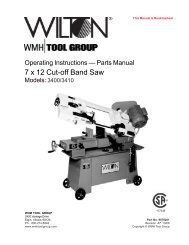This Rigger's Handbook is dedicated to Theodore C - Igor Chudov
This Rigger's Handbook is dedicated to Theodore C - Igor Chudov
This Rigger's Handbook is dedicated to Theodore C - Igor Chudov
You also want an ePaper? Increase the reach of your titles
YUMPU automatically turns print PDFs into web optimized ePapers that Google loves.
YOUR SLING AND RIGGING SPECIALIST<br />
5.2 - MECHANICAL CONSIDERATIONS<br />
HEADQUARTERS: 55 James E. Casey Drive • Buffalo, NY 14206 PHONE: 716.826.2636 FAX: 716.826.4412 www.hanessupply.com<br />
55<br />
Nylon Web Slings<br />
5.2.1 Determine weight of the load. The weight of the load shall be within the rated capacity of<br />
the sling.<br />
5.2.2 Select the proper sling having suitable character<strong>is</strong>tics for the type of load, hitch and<br />
environment.<br />
5.2.3 Slings shall not be loaded in excess of the rated capacity. Consideration should be given<br />
<strong>to</strong> the angle of lift (sling-<strong>to</strong>-load angle), which affects rated capacity.<br />
5.2.4 Slings with fittings which are used in a choker hitch shall be of sufficient length <strong>to</strong> assure<br />
that the choking action <strong>is</strong> on the webbing, and never on the other fitting.<br />
5.2.5 Slings used in a basket hitch shall have the load balanced <strong>to</strong> prevent slippage.<br />
5.2.6 The opening in fittings shall be the proper shape and size <strong>to</strong> insure that the fitting will seat<br />
properly in the hook or other attachments.<br />
5.2.7 Slings shall always be protected from being cut by sharp corners, sharp edges, protrusions<br />
or abrasive surfaces.<br />
5.2.8 Slings shall not be dragged on the floor or over an abrasive surface.<br />
5.2.9 Slings shall not be tw<strong>is</strong>ted or tied in<strong>to</strong> knots, or joined by knotting.<br />
5.2.10 Slings shall not be pulled from under loads when the load <strong>is</strong> resting on the sling.<br />
5.2.11 Do not drop slings equipped with metal fittings.<br />
5.2.12 Slings that appear <strong>to</strong> be damaged shall not be used unless inspected and accepted as<br />
usable under Section 5.2.<br />
5.2.13 The sling shall be hitched in a manner providing control of the load.<br />
5.2.14 Portions of the human body should be kept from between the sling and the load, and from<br />
between the sling and the crane hook or ho<strong>is</strong>t hook.<br />
5.2.15 Personnel should stand clear of the suspended load.<br />
5.2.16 Personnel shall not ride the sling.<br />
5.2.17 Shock loading should be avoided.<br />
5.2.18 Tw<strong>is</strong>ting the legs (branches) shall be avoided.<br />
5.2.19 Load applied <strong>to</strong> the hook should be centered in the base (bowl) of hook <strong>to</strong> prevent point<br />
loading on the hook.<br />
5.2.20 During lifting, with or without the load, personnel shall be alert for possible snagging.<br />
5.2.21 The slings' legs (branches) should contain or support the load from the sides above the<br />
center of gravity when using a basket hitch.<br />
5.2.22 Slings shall be long enough so that the rated load (rated capacity) <strong>is</strong> adequate when the<br />
angle of the legs (branches) <strong>is</strong> taken in<strong>to</strong> consideration.
















